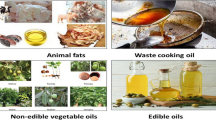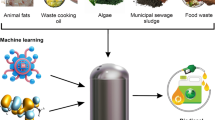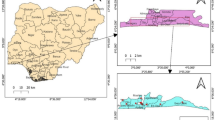Abstract
This research reports the application of recursive neural network–particle swarm (RNN–PS) and nonlinear multivariate rational function (NLMRF) algorithms for optimization of biodiesel derived from non-edible feedstock of Hevea brasiliensis. Nonlinear auto-regressive with external input (NARX) model was applied with four input variables: time (45–65 min), process temperature (45–65 °C), methanol/oil molar proportion (4:1–12:1) and catalyst dosage (0.5–1.5 wt%), one target (biodiesel yield) and two delays. The RNN showed better correlation (SSE = 21.14 and R2 = 0.98) than the three NLMRFs (SSE > 300 and R2 < 0.63). Optimum conditions obtained with RNN–PS hybrid heuristic model were 60.55 min, 70 °C, methanol/oil molar ratio of 6.89 and catalyst concentration of 1.5wt% with a maximum biodiesel yield of 92.77wt% and experimental validation of 92.52 wt%. Sensitivity analysis result shows that the level of the impact of the input variables on the independent responses follows the order: catalyst concentration (43.77%) > reaction time (24.22%) > methanol/HBSO molar ratio (21.89%) > reaction temperature (10.12%). RNN–PS exhibited high capability in excellent capturing of mapping, great diversity trajectory search, rapid convergence and intrinsic guidance strategy. Functional groups, fatty acid compositions and physicochemical characteristics of the biodiesel obtained using Fourier transform infrared (FTIR), gas chromatography flame ionization detector (GC-FID) and American Standard for Material Testing (ASTMD) methods show that the quality of the biodiesel agreed with international standards. RNN–PSO is therefore proposed as a meta-heuristic and reliable optimization tool for developing a viable and sustainable route for biodiesel fuel production.












Similar content being viewed by others
Abbreviations
- \({A}_{\mathrm{IS}}\) :
-
Area under thri-internal standard peak (µV*sec)
- \({M}_{\mathrm{IS}}\) :
-
Weight of applied internal standard (mg)
- \({\Sigma }_{\mathrm{A}}\) :
-
Summed area under peak for fatty acids (µV/sec)
- X 1 :
-
Reaction time (min)
- a 0–a 14 :
-
Coefficients to be determined
- X 2 :
-
Reaction temperature (°C)
- X 3 :
-
Methanol/HBSO molar ratio
- C 1,C 2 :
-
Weights of local global information
- CV:
-
Coefficient of variance
- X 4 :
-
Catalyst concentration (wt%)
- GA:
-
Genetic algorithm
- gBest:
-
Best position of swarm
- h:
-
Hidden layers
- I :
-
Input layers
- k :
-
Input neurons
- M :
-
Mass of biodiesel sample (mg)
- m :
-
Hidden neurons
- M FAME :
-
Average molecular mass of biodiesel
- n h :
-
Number of hidden neurons
- n :
-
Output neurons
- NARX:
-
Nonlinear auto-regressive with external input
- n i :
-
Number of input neurons
- NLMRF :
-
Nonlinear multivariate rational function
- o:
-
Output layers
- P:
-
Particles current position
- pBest:
-
Best position of particle
- PSO:
-
Particle swarm optimization
- r 1,r 2 :
-
Two random variables
- S j :
-
Significance of the jth input parameter
- V :
-
Particle velocity
- W :
-
Weight
- W FAME :
-
Produced biodiesel (mg)
- X 1-X 4 :
-
Independent variables
- Y :
-
Actual response
- Y m :
-
Mean of the actual response
- Y p :
-
Predicted response
References
Wang, B.; Yang, Z.; Xuan, J.; Jiao, K.: Crises and opportunities in terms of energy and AI technologies during the COVID-19 pandemic. Energy AI 1, 100013 (2020). https://doi.org/10.1016/j.egyai.2020.100013
Esonye, C.; Onukwuli, O.D.; Ofoefule, A.U.: Optimization of production from prunus amygdalus seed oil using response surface methodology and artificial neural networks. Renew. Energy 130, 62–71 (2019). https://doi.org/10.1016/j.renene.2018.06.036
Chen, S.; Ren, Y.; Friedrich, D.; Yu, Z.: Analysis to reduce duplicated features in ANN training for district heat demand prediction. Energy AI (2020). https://doi.org/10.1016/j.egyai2020.100028
Halit, A.; Hajar, F.; Mohammad, T.S.; Muslume, S.C.; Shahaboddin, S.; Kwok, W.CH.; Abdelbaki, E.; Geleribe, V.; Khamy, S.E.E.: Analog hardware implementation of random neural network model. In: Proceeding of International Joint Conference on Neural Networks. IJCNN, vol. 4, pp. 197–201 (2000)
Uzoh, F.C.; Nwekwe, A.; Onukwuli, O.; Ofochebe, S.; Ezekannagha, C.: Optimal route for effective conversion of rubber seed oil to biodiesel with desired key fuel properties. J. Clean. Prod. (2020). https://doi.org/10.1016/j.jdepro.124563
Naik, A.; Satapathy, S.C.; Abraham, A.: Modified socio-group optimization—a meta heuristic algorithm to solve short-term hydro thermal scheduling. Appl. Soft Comput. J. 95, 1065 (2020). https://doi.org/10.1016/j.asoc.2020.106524
Nassef, A.M.; Sayed, E.T.; Rezek, H.; Abdelkareem, M.A.; Rodriguez, C.; Olabi, A.G.: Fuzzy-model with particle swarm optimization for enhancing the production of biodiesel from microalgae. Energy Sources Part A Recovery, Utilization and Environmental Effects (2018). https://doi.org/10.1080/155670362018.1549171
Leke, Z.; Falah, Y.H.A.; Adam, A.J.: Concepts, methods and performance of particle swarm optimization, back-propagation and neural networks. Appl. Comput. Intell. Soft Comput. (2018). https://doi.org/10.1155/2018/9547212
Hoda, Z.; Mohammad, H.N.; Ami, R.H.G.: CCSA Conscious neighborhood-based crow search algorithm for solving global optimization problems. Appl. Soft Comput. 85, 105583 (2019)
SaiBharadwaj, A.V.S.L.; Niju, S.; Meera, S.B.K.M.; Anantharaman, N.: Effect of rubber seed oil biodiesel on engine performance and emission analysis. Fuel (2021). https://doi.org/10.1016/j.fuel.2021.120708
Food and Agriculture Organization. National rubber: top 10 producers 2019 (2019). http://www.fao.org/faostat/en/data/QC/visualize
Ulfa, M.; Mulyaziri; Burmawi; Praputri, E.; Sundari, E.; Firdaus, U.: Biodiesel production methods of rubber seed oil: a review. In: IOP Conference Series Materials and Science and Engineering, vol. 334, p. 012006 (2018). https://doi.org/10.1088/1757-899X/344/1/012006
Onoji, S.E.; Iyuke, S.E.; Igbaje, A.I.; Nkazi, A.B.: Rubber seed oil: a potential renewable source of biodiesel for sustainable development in sub-saharan Africa. Energy Convers. Manag. 110, 125–134 (2016)
Ennetta, R.; Soyhan, H.S.; Koyunoglu, C.: Current technologies and future trends for biodiesel production: a review. Arab J Sci Eng. (2022). https://doi.org/10.1007/s13369-022-07121-9
Esonye, C.; Onukwuli, O.D.; Ofoefule, A.U.: Chemical kinetics of a two-step transesterification of dyacrodes edulis seed oil using acid-alkali catalyst. Chem. Eng. Res. Des. 145, 245–257 (2019). https://doi.org/10.1016/j.cherd.2019.03.010
Bello, E.I.; Otu, F.: Physico-chemical properties of rubber (Hevea brasiliensis) seed oil, its biodiesel and blends with Diesel. Br. J. Appl. Sci. Technol. 6(3), 261–275 (2015). https://doi.org/10.9734/BJAST/2015/12548
Iyayi, A.F.; Akpaka, P.O.; Ukpeoyibo, U.: Rubber seed processing for value-added latex production in Nigeria. Afr. J. Agric. Food Secur. 8(11), 001–005 (2020)
Omokhafe, K.O.; Alika, J.E.: Clonal variation and correlation of seed characters in Hevea brasiliensis Muell Arg. Ind. Crops Prod. 19(2), 175–184 (2004)
Sai, B.A.V.S.L.; Niju, S.; Khadhar, M.; Meere Sheriffa, B.; Anantharaman, N.: Optimization of continuous biodiesel production from rubber seed oil (RSO) using calcined egg shell as heterogeneous catalyst. J. Environ. Chem. Eng. 8(1), 103603 (2020)
Soltani, H.; Karimi, A.; Falahatpisheh, S.: The optimization of biodiesel production from transesterification of sesame oil via applying ultrasound assisted techniques: comparison of RSM and ANN-PSO hybrid model. Chem. Prod. Process. Model. (2020). https://doi.org/10.1515/cppm-2020-0076
Abdul, F.P.; Priji, P.; Unni, K.N.; Mohanan, K.V.: Optimization of parameters for the production of biodiesel from rubber seed oil using Onsite lipase by response surface methodology. Biotech 8(11), 459 (2018). https://doi.org/10.1007/5/3205-018-1447-7
Aryasomayajula Venkata Satya Lakshmi, S.B.; Subramania Pillai, N.; Khadhar Mohamed, M.S.B.: Biodiesel production from rubber seed oil using calcined eggshells impregnated with Al2O3 as heterogeneous catalyst: a comparative study of RSM and ANN optimization. Braz. J. Chem. Eng. 37, 351–368 (2020)
Onukwuli, O.D.; Esonye, C.; Ofoefule, A.U.; Eyisi, R.: Comparative analysis of the application of artificial neural network-genetic algorithm and response surface methods-desirability function for predicting the optimal conditions for biodiesel synthesis from chrysophyllum albidum seed oil. J. Taiwan Inst. Chem. Eng. 125(3), 153–167 (2021). https://doi.org/10.1016/j.jtice.2021.06.012
Ofoefule, A.U.; Esonye, C.; Onukwuli, O.D.; Nwaeze, E.; Ume, C.S.: Modeling and optimization of African pear seed oil esterification and transesterification using artificial neural network and response surface methodology comparative analysis. Ind. Crops Prod. 140, 111707 (2019). https://doi.org/10.1016/j.indcrop.2019.111707
AOAC: Official Methods of Analysis, 21st edn. Association of Official Analytical Chemists, Washington, DC (2019)
Ahmad, J.; Yusup, S.; Bokhari, A.; Kamil, R.N.M.: Study of fuel properties of rubber seed oil-based biodiesel. Energy Convers. Manag. 78, 266–275 (2014)
Abdoli, M.A.; Mohamadi, F.; Ghobadian, B.; Fayyazi, E.: Effective parameters on biodiesel production from feather fat oil as a cost-effective feedstock. Int. J. Environ. Res. 8(1), 139–148 (2014)
Oznan, I.; Claire, C.: Deep Recursive neural networks for compositionality in languages. In: Advances in Neural Information Processing Systems 27, NIPS Proceedings (2014)
Rezk, H.; Fatty, A.; Abdelaziz, A.Y.: A comparison of global MPPT techniques based on meta-heuristic algorithms for photovoltaic system subjected to partial shading conditions. Renew. Sustain. Energy Rev. 74C, 377–386 (2017). https://doi.org/10.1016/j.rser.2017.02.051
Mohamed, M.A.; Zaki Diab, A.A.; Rezk, H.: Partial shading mitigation of PV systems via different meta-heustic techniques. Renew. Energy 130C, 1159–1175 (2019). https://doi.org/10.1016/j.rene.2018.08.077
Betiku, E.; Ishola, N.B.: Optimization of sorrel oil biodiesel production by base heterogeneous catalyst from kola nut pod husk: neural intelligence-genetic algorithm versus neuro-fuzzy-genetic algorithm. Environ. Prog. Sustain. Enegry 39, 13393 (2020). https://doi.org/10.1002/ep.13393
Okpalaeke, K.E.; Ibrahim, T.H.; Latinwo, L.M.; Betiku, E.: Mathemtical modeling and optimization studies by Artitifical neural network, genetic algorithm and response surface methodology: a case of Ferric sulfate - catalyzed esterification of Neem (azadirchta indica) seed oil. Front. Energy Res. 8, 614621 (2020). https://doi.org/10.3389/fenrg.2020.614621
Buassri, A.; Loryuenyong, V.: Continuous production of biodiesel from rubber seed oil using a packed reactor with BaCl2 impregnated CaO as catalyst. Bull. Chem. React. Eng. Catal. 13(2), 320–330 (2018)
Awolu, O.O.; Layokun, S.K.: Optimization of two-step transesterification production of biodiesel from neem (Azadirachta indica) oil. Int. J. Energy Environ. Eng. 4, 39–47 (2013)
Sivaramakrishnam, K.; Ravikumar, P.: Determination of cetane number of biodiesel and its influence on physical properties. ARFN J. Eng. Appl. Sci. 7(2), 205–211 (2012)
Juanaid, G.; Suzana, Y.; Awais, B.; Ruzaimah, N.M.K.: Study of fuel properties of rubber seed oil-based biodiesel. Energ. Convers. Manag 74, 266–275 (2014)
Haswin Kaur G. S.; Yusup, S.; Wai, C. K.: Physico-chemical properties of crude rubber see oil for gasoline production. In: 4th International Conference on Process Engineering and Advanced Materials. Procedia Engineering, vol. 148, pp. 426–431 (2016)
Roschat, W.; Siritanon, T.; Yoosuk, B.; Sudyoadsuk, T.; Promarak, V.: Rubber seed oil as potential non-edible feedstock for biodiesel production using heterogeneous catalyst in Thailand. Renew.e Energy 101, 937–944 (2017)
Acknowledgements
The authors are thankful to Springboard Laboratories, Awka, and NOTAP/PZ laboratory, Alex Ekwueme Federal University Ndufu Alike, Abakaliki, for the availability of laboratory apparatus and analytical equipment.
Funding
Only the authors funded this research.
Author information
Authors and Affiliations
Corresponding author
Ethics declarations
Conflict of interests
The authors declare that they have no known competing financial interests or personal relationships that could have appeared to influence the work reported in this paper.
Rights and permissions
Springer Nature or its licensor (e.g. a society or other partner) holds exclusive rights to this article under a publishing agreement with the author(s) or other rightsholder(s); author self-archiving of the accepted manuscript version of this article is solely governed by the terms of such publishing agreement and applicable law.
About this article
Cite this article
Esonye, C., Onukwuli, O.D., Ubaka, O.C. et al. Recursive Neural Network–Particle Swarm Versus Nonlinear Multivariate Rational Function Algorithms for Optimization of Biodiesel Derived from Hevea brasiliensis. Arab J Sci Eng 48, 15979–15998 (2023). https://doi.org/10.1007/s13369-023-07947-x
Received:
Accepted:
Published:
Issue Date:
DOI: https://doi.org/10.1007/s13369-023-07947-x




